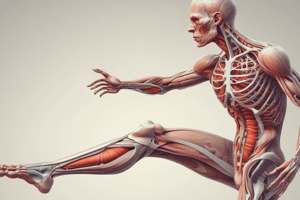Podcast
Questions and Answers
What percentage of body fluid do infants have approximately?
What percentage of body fluid do infants have approximately?
- 60%
- 55%
- 45%
- 75% (correct)
Which factor influences the percentage of body fluid in an individual?
Which factor influences the percentage of body fluid in an individual?
- Weight
- Diet
- Height
- Age (correct)
What is the approximate percentage of body fluid in lean adult females?
What is the approximate percentage of body fluid in lean adult females?
- 50%
- 60%
- 65%
- 55% (correct)
What is the main difference between the body fluid composition of lean adult males and lean adult females?
What is the main difference between the body fluid composition of lean adult males and lean adult females?
What are the two major body fluid compartments?
What are the two major body fluid compartments?
Why is it important to understand the factors that influence the percentage of body fluid?
Why is it important to understand the factors that influence the percentage of body fluid?
What is the main component of the total body fluid?
What is the main component of the total body fluid?
What is found in higher concentration in the ECF compared to the ICF?
What is found in higher concentration in the ECF compared to the ICF?
Which of the following is a function of the plasma membrane and capillary wall?
Which of the following is a function of the plasma membrane and capillary wall?
What is the process called that moves fluid between the major body fluid compartments?
What is the process called that moves fluid between the major body fluid compartments?
When the blood plasma is hypotonic to the interstitial fluid, what happens to the water?
When the blood plasma is hypotonic to the interstitial fluid, what happens to the water?
What are the two major fluid compartments in the body?
What are the two major fluid compartments in the body?
What percentage of daily fluid intake is accounted for by ingested water?
What percentage of daily fluid intake is accounted for by ingested water?
What is the approximate amount of fluid produced daily from metabolic processes?
What is the approximate amount of fluid produced daily from metabolic processes?
What is the purpose of fluid intake in the body?
What is the purpose of fluid intake in the body?
What is the categorization of fluid loss that is measurable and regulated based on the state of hydration of the body?
What is the categorization of fluid loss that is measurable and regulated based on the state of hydration of the body?
What is the sources of fluid loss from the body?
What is the sources of fluid loss from the body?
What happens when the blood plasma becomes hypertonic?
What happens when the blood plasma becomes hypertonic?
What is fluid balance?
What is fluid balance?
Why is fluid balance important?
Why is fluid balance important?
What are the two categories of fluid intake?
What are the two categories of fluid intake?
What is the result of fluid balance in the body?
What is the result of fluid balance in the body?
What is regulated to maintain fluid balance?
What is regulated to maintain fluid balance?
What is the direction of water movement when the blood plasma becomes hypertonic?
What is the direction of water movement when the blood plasma becomes hypertonic?
What is the primary goal of fluid balance in the body?
What is the primary goal of fluid balance in the body?
What is the purpose of metabolic water in the body?
What is the purpose of metabolic water in the body?
What systems are involved in regulating fluid balance?
What systems are involved in regulating fluid balance?
What is the result of fluid imbalance in the body?
What is the result of fluid imbalance in the body?
What is the significance of understanding fluid balance for healthcare professionals?
What is the significance of understanding fluid balance for healthcare professionals?
What is the primary reason elderly individuals are more susceptible to fluid imbalance?
What is the primary reason elderly individuals are more susceptible to fluid imbalance?
What is the difference in the percentage of body fluid between lean adult females and lean adult males?
What is the difference in the percentage of body fluid between lean adult females and lean adult males?
Which of the following statements is true about the chemical composition of the ICF and ECF?
Which of the following statements is true about the chemical composition of the ICF and ECF?
Why is it important to consider the age of an individual when assessing their fluid balance?
Why is it important to consider the age of an individual when assessing their fluid balance?
What is the significance of the ratio of adipose connective tissue to skeletal muscle tissue in determining the percentage of body fluid?
What is the significance of the ratio of adipose connective tissue to skeletal muscle tissue in determining the percentage of body fluid?
What is the primary consequence of having a lower percentage of body fluid?
What is the primary consequence of having a lower percentage of body fluid?
What is the primary reason for the difference in chemical composition between the ICF and ECF?
What is the primary reason for the difference in chemical composition between the ICF and ECF?
What happens when the blood plasma becomes hypotonic to the interstitial fluid and the ICF?
What happens when the blood plasma becomes hypotonic to the interstitial fluid and the ICF?
What is the primary characteristic of the ICF that distinguishes it from the ECF?
What is the primary characteristic of the ICF that distinguishes it from the ECF?
What is the role of osmosis in the movement of fluid between the major body fluid compartments?
What is the role of osmosis in the movement of fluid between the major body fluid compartments?
What is the composition of the ECF in terms of ions?
What is the composition of the ECF in terms of ions?
What is the relationship between the concentration of solutes in the ICF and ECF?
What is the relationship between the concentration of solutes in the ICF and ECF?
What is the daily contribution of metabolic water to the body?
What is the daily contribution of metabolic water to the body?
What is the primary source of daily fluid intake?
What is the primary source of daily fluid intake?
What is the classification of fluid loss that is not measurable and not regulated by the body?
What is the classification of fluid loss that is not measurable and not regulated by the body?
What is the purpose of fluid output in the body?
What is the purpose of fluid output in the body?
What is the relationship between fluid intake and fluid output in the body?
What is the relationship between fluid intake and fluid output in the body?
What is the primary reason why infants have a higher percentage of body fluid compared to elderly individuals?
What is the primary reason why infants have a higher percentage of body fluid compared to elderly individuals?
What is the significance of the difference in chemical composition between the ICF and ECF?
What is the significance of the difference in chemical composition between the ICF and ECF?
What is the primary consequence of having a lower percentage of body fluid in elderly individuals?
What is the primary consequence of having a lower percentage of body fluid in elderly individuals?
Why do lean adult females have a lower percentage of body fluid compared to lean adult males?
Why do lean adult females have a lower percentage of body fluid compared to lean adult males?
What is the significance of understanding the factors that influence the percentage of body fluid in individuals?
What is the significance of understanding the factors that influence the percentage of body fluid in individuals?
What is the primary role of the ratio of adipose connective tissue to skeletal muscle tissue in determining the percentage of body fluid?
What is the primary role of the ratio of adipose connective tissue to skeletal muscle tissue in determining the percentage of body fluid?
What is the primary mechanism that helps maintain fluid balance in the body?
What is the primary mechanism that helps maintain fluid balance in the body?
What is the primary purpose of categorizing fluid loss as sensible or insensible?
What is the primary purpose of categorizing fluid loss as sensible or insensible?
What is the primary consequence of a disruption in fluid balance?
What is the primary consequence of a disruption in fluid balance?
What is the primary reason for the difference in the concentration of potassium ions between the ICF and ECF?
What is the primary reason for the difference in the concentration of potassium ions between the ICF and ECF?
What is the relationship between fluid intake and fluid output in the body?
What is the relationship between fluid intake and fluid output in the body?
What is the approximate amount of fluid produced daily from metabolic processes?
What is the approximate amount of fluid produced daily from metabolic processes?
What is the primary function of the lymphatic system in maintaining fluid balance?
What is the primary function of the lymphatic system in maintaining fluid balance?
When the concentration of solutes in the ICF is higher than in the ECF, what happens to the water?
When the concentration of solutes in the ICF is higher than in the ECF, what happens to the water?
What is the primary function of the capillary wall in relation to fluid balance?
What is the primary function of the capillary wall in relation to fluid balance?
What is the primary category of fluid intake that is not dependent on dietary intake?
What is the primary category of fluid intake that is not dependent on dietary intake?
What is the primary source of daily fluid intake?
What is the primary source of daily fluid intake?
What is the primary factor that influences the distribution of solutes in the body's fluid compartments?
What is the primary factor that influences the distribution of solutes in the body's fluid compartments?
What is the result of the movement of water from the ECF to the ICF?
What is the result of the movement of water from the ECF to the ICF?
What is the category of fluid loss that includes fluid lost through sweat and cutaneous transpiration?
What is the category of fluid loss that includes fluid lost through sweat and cutaneous transpiration?
What is the primary mechanism by which the body regulates fluid balance?
What is the primary mechanism by which the body regulates fluid balance?
What is the primary importance of understanding fluid balance in healthcare professionals?
What is the primary importance of understanding fluid balance in healthcare professionals?
What is the relationship between the concentration of solutes in the ICF and the movement of water?
What is the relationship between the concentration of solutes in the ICF and the movement of water?
Study Notes
Fluid Balance and Body Fluid Compartments
- Fluid balance refers to the state in which the amount of fluid intake into the body is equal to the amount of fluid output, resulting in a normal distribution of water and solutes in the major fluid compartments of the body.
- Fluid balance is essential for maintaining optimal health and involves the coordination of various systems, including the digestive, cardiovascular, lymphatic, integumentary, respiratory, urinary, nervous, and endocrine systems.
Sources of Fluid Intake and Categories of Water Loss
- Fluid intake is the addition of water to the body and is divided into two categories: ingested water and metabolic water.
- Ingested water includes the water absorbed from food and drink taken into the GI tract, accounting for approximately 92% of daily fluid intake.
- Metabolic water includes the water produced daily from aerobic cellular respiration and dehydration synthesis, totaling approximately 200 mL of fluid per day.
- Fluid output is the loss of water from the body and must equal fluid intake to maintain fluid balance.
- Fluid output can be categorized as either sensible or insensible water loss and as either obligatory or facultative water loss, depending on whether the loss is measurable and regulated based on the state of hydration of the body.
Factors Influencing Percentage of Body Fluid
- The percentage of body fluid is influenced by two main factors: age and the ratio of adipose connective tissue to skeletal muscle tissue.
- Infants have the highest percentage of fluid, at approximately 75% fluid by weight, while elderly individuals have the lowest percentage of fluid at 45%.
- The ratio of adipose connective tissue to skeletal muscle tissue plays a role in determining the percentage of body fluid.
- Lean adult females, on average, are typically composed of 55% body fluid, whereas lean adult males are, on average, typically composed of 60% body fluid.
Body Fluid Compartments
- The two major body fluid compartments are the intracellular fluid (ICF) and the extracellular fluid (ECF).
- The ICF is the fluid within our cells, comprising approximately two-thirds of the total body fluid.
- The ICF contains a higher concentration of potassium (K+), magnesium (Mg2+), phosphate anion (PO43-), and negatively charged proteins compared to the ECF.
- The ECF includes both interstitial fluid (IF), which surrounds and "bathes" the cells, and blood plasma within the blood vessels.
- The ECF is composed of sodium (Na+), chloride (Cl-), and bicarbonate (HCO3-) ions, with a higher concentration of protein in the blood plasma compared to the interstitial fluid.
Movement of Fluid between Body Fluid Compartments
- Fluid moves between the major body fluid compartments through the process of osmosis, which is driven by differences in solute concentration.
- When there is a relative difference in the concentration of solutes between the ICF and ECF, water moves by osmosis to equalize the concentration.
- For example, when the blood plasma becomes hypotonic to the interstitial fluid and the ICF, water moves from the blood plasma into the interstitial fluid and then into the cells.
- Conversely, when the blood plasma becomes hypertonic, water moves from the cells into the interstitial fluid and then into the blood plasma.
Studying That Suits You
Use AI to generate personalized quizzes and flashcards to suit your learning preferences.
Related Documents
Description
Learn about the factors that affect the percentage of body fluid, including age and body composition, and understand their significance in maintaining fluid balance. Discover how body fluid percentage changes across the lifespan. Test your knowledge of human physiology and health!




